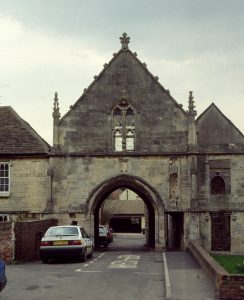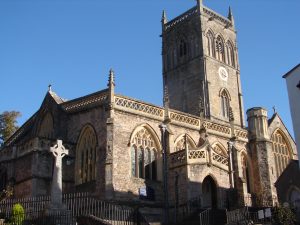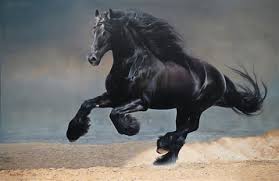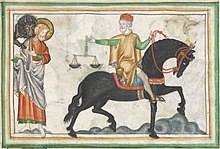It is difficult to overstate the importance of the church in western Europe and the British Isles in 1400, the year in which Effigy of the Cloven Hoof, the first novel in my Lady Apollonia West Country Mysteries, is set. Therefore, there are many ways in which the significance of the Roman Catholic Church is portrayed through the characters’ lives in my novels.
The 15th century Church was critical in the life of my heroine, the Lady Apollonia, and throughout her household, known as her affinity. Two members of her household were clerics: her almoner, Brother William, and her chaplain, Friar Francis. She calls on these churchmen to play important roles to help her deal with calamities at the beginning of the story. Then, the Lady and other members of her affinity retreat to the refuge of her household chapel in Aust Manor to help them cope with problems already arising in the Prologue of the book.
The third of Apollonia’s five sons, Thomas, became a priest and served as the rector of the parish church in Axbridge, Somerset. Father Thomas appears occasionally through all my novels except for Plague of as Green Man, set in 1380, when Thomas was only ten years of age. He served for many years as a parish priest there including when the real parish church of Axbridge was built to its present form at the beginning of the 15th century. A picture of that church is shown above. It was while The Lady was visiting Father Thomas in Axbridge that he introduced his mother to Chaucer’s Canterbury Tales which I mentioned in my previous posting.
 The importance of monastic institutions of the church to medieval life is readily apparent in Effigy of the Cloven Hoof. One of the bodies discovered in the early chaos of the story is a nobleman who is taken to nearby Kingswood Abbey for safe keeping after Lady Apollonia tentatively identifies him as someone whose family might wish to do her or her affinity harm. The ruins of the gatehouse to Kingswood Abbey are shown on the left. In my story, this Cistercian abbey provided refuge for Lady Apollonia until her she was reassured that she could safely return to her home in the village of Aust.
The importance of monastic institutions of the church to medieval life is readily apparent in Effigy of the Cloven Hoof. One of the bodies discovered in the early chaos of the story is a nobleman who is taken to nearby Kingswood Abbey for safe keeping after Lady Apollonia tentatively identifies him as someone whose family might wish to do her or her affinity harm. The ruins of the gatehouse to Kingswood Abbey are shown on the left. In my story, this Cistercian abbey provided refuge for Lady Apollonia until her she was reassured that she could safely return to her home in the village of Aust.
The next monastery to appear in this story is Laycock Abbey in Wiltshire, a nunnery of the Augustinian order. Lady Apollonia occasionally retreated to this abbey during her first marriage which is described in a flashback in the story. After the trauma of the death of her first husband, Geoffrey Montecute, it was natural that she would retreat to this favored nunnery as she sought to deal with the challenges of widowhood and the personal guilt she was struggling with. It is during this stay in Lacock Abbey when Apollonia is introduced to the writings of Mother Julian of Norwich whom I mentioned in my last posting. These Seeings of Mother Julian were most helpful to Lady Apollonia in regaining balance in life.
When Lady Apollonia makes a trip to Somerset in Effigy of the Cloven Hoof, she stays in monastic guest accommodations. One of these is Stogursey Priory in the village of Stogursey, about half-way between Axbridge where Lady Apollonia’s son Thomas was the parish priest, and Dunster, her last stop on the trip to Cliffbarton. Stogursey Priory was donated as a cell to the Benedictine Abbey of St Mary at Lonlay, France. Her next stop on her way was in Dunster where, in 1346, Cleeve Abbey had built a nunnery never inhabited by nuns but was used as a guest house. I have used this guest house as Apollonia’s last stop before her destination of Cliffbarton and her first stop on the way home to Aust.
It can be seen what an important role monasteries played in 1400, but in my next post, I will discuss other ways in which the church was central to life in the Middle Ages and in my stories about Lady Apollonia of Aust.


